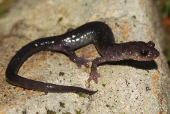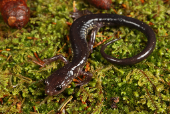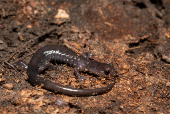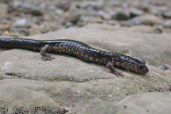Wehrle's Salamander (Plethodon wehrlei)
Description: It is bluish-black with big, scattered white spots on its back. Its sides are covered with white to yellow spots and blotches. Its belly and the ventral surface of the tail are solid gray, and the throat and upper chest usually have white or yellowish blotches. The species grows to a length of 3.9 to 6.7 inches.
Habitat: This species is found on forested hillsides in the Appalachian Plateau, where it hides by day beneath stones or rocks. It is also found at the entrances of caves and deep rock crevices, as well as burrows under rocks and logs.
Range: Wehrle's salamander ranges from New York south to Virginia. Populations in southwestern Virginia and northwestern North Carolina were reclassified as a distinct species, the Blacksburg salamander (P. jacksoni), which has been reaffirmed by a study published in 2019. An isolated cave-dwelling population in Virginia was also reclassified as distinct species, the Dixie Caverns salamander (P. dixi), also reaffirmed by a study published in 2019. The population on the Cumberland Plateau, formerly considered a yellow-spotted color morph, is now considered a new species, the yellow-spotted woodland salamander (P. pauleyi), which was described during the 2019 study.
Diet: This salamander forages at night within low vegetation for ants, mites, spiders, beetles, and other terrestrial invertebrates.
Reproduction: Mating occurs from fall through spring. A large cluster of eggs is laid in early summer in damp logs, soils or moss, and in crevices in caves. Reproduction is biennial or irregular, with many mature females failing to breed each year.
Status: Listed as Least Concern in view of its wide distribution and presumed large and stable population.
»» Kingdom: Animalia - Animals
»» Phylum: Chordata - Chordates
»» Subphylum: Vertebrata - Vertebrates
»» Class: Amphibia - (Amphibians)
»» Order: Caudata - Salamanders
»» Family: Plethodontidae - Lungless Salamanders
»» Genus: Plethodon
»» Species: Plethodon wehrlei - Wehrle's Salamander
This article uses material from the Wikipedia article "Wehrle's Salamander", which is released under the Creative Commons Attribution-Share-Alike License 3.0. Content may have been omitted from the original, but no content has been changed or extended.
|













